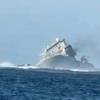AAPA Calls for “Continued Progress” in Port Security
“Ports are a vital part of our nation’s transportation infrastructure and serve as international borders to nearly all U.S. overseas trade,” said Mr. Nagle. “With cargo volumes projected to double by 2020 and cruise passenger embarkations rising an average of 8 percent a year, ports must be secure and able to handle America’s international commerce.
“AAPA and its members are fully committed to the security of America’s seaports,” he added. “Protecting ports is essential for the nation’s economic growth, vitality and way of life.” The comprehensive Maritime Transportation Security Act (MTSA) of 2002 changed the way ports handle cargo and passenger movements. To implement MTSA security measures, America’s ports and their terminal operators have invested hundreds of millions of dollars in enhancements in areas such as perimeter security, access control and credential systems, interoperable communications technology, waterside security, security personnel and training.
In representing the broad security needs of its members, AAPA’s Security Committee and a Port Security Task Force meet regularly to discuss port security and share best practices and lessons learned. The Security Committee conducts an annual Port Security Seminar and has developed a comprehensive port security manual.
The industry also maintains ongoing liaison with the federal government’s lead port and maritime security agencies. These dialogues address timely security issues such as the pending Transportation Worker Identification Credential (TWIC), which the Transportation Security Administration (TSA) and Coast Guard are implementing to ensure those seeking access to secure port areas can be positively identified, have authorization to enter the facility and do not pose a terrorist risk. The Association strongly supports the federal government’s layered security approach and advocates Congress to provide adequate resources to agencies such as the Coast Guard, CBP, TSA, and Immigration and Customs Enforcement, which take the lead on port and maritime security to enable them to continue to carry out and enhance their security programs.
In concert with public port authorities and terminal operators, the Coast Guard is charged with routinely inspecting and assessing the security of U.S. port facilities and the vessels that call those facilities, in accordance with the MTSA and the International Ship and Port Facility Security Code. Since 9/11, the Coast Guard has instituted innovative programs such as Maritime Safety and Security Teams, enforced security zones, increased its intelligence gathering and analysis capabilities, expanded its partnerships with the maritime industry, international organizations, federal, state and local agencies, and has joined with other agencies within DHS to strengthen our nation’s borders and protect America’s ports and waterways. According to the Coast Guard’s Washington, D.C., media relations office, major accomplishments since 9/11 include:
· Implemented the MTSA of 2002 and Spearheaded the International Ship and Port Facility Security (ISPFS) Code: The MTSA strengthened and standardized security measures at U.S. ports and authorized the creation of Coast Guard Maritime Safety and Security Teams. The ISPFS code requires all ships and ports engaging in international trade to submit port facility and ship security plans to their home government. The Coast Guard ensures all visiting foreign vessels have complied with the code requirements and examines those foreign vessels deemed high risk.
· Developed Area Maritime Security Committees: These committees comprise federal, state, local, and private authorities to enhance security efforts in approximately 50 major ports, of which AAPA U.S.-member ports participate.
· Increased Oversight of Vessel Security: Instituted the 96-Hour Advance Notice of Arrival rule for vessels, increased scrutiny of high interest vessels and accelerated international requirements for the Automatic Identification System to keep track of vessel movements.
· Implemented the International Port Security Program: Assessed the anti-terrorism measures of 140 U.S. trade partners, and identified and conducted additional port state control activities on vessels whose countries failed to implement requirements of the ISPFS Code.
· Completed Port Security Assessments: Created port security teams to assess 55 militarily and economically strategic ports and an additional six ports. Completed special assessments on several classes of vessels including ferries, LNG vessels, certain dangerous cargo barges and single skin tank vessels. Developed the port security risk assessment tool to assess and establish risk-based profiles.
Also working with the ports, terminal operators and Coast Guard is CBP. While the Coast Guard is responsible for facility and vessel security, CBP’s mission is primarily related to cargo security, including preventing terrorists and terrorist weapons from entering the U.S. by eliminating potential threats before they arrive at our borders and ports.
According to CBP’s 7/12/2006 newsroom fact sheet (www.cbp.gov), some of the programs it has implemented at U.S. ports and abroad since 9/11 include:
· Screening and Inspection: CBP screens 100 percent of all cargo before it arrives in the U.S and inspects all high-risk cargo.
· CSI (Container Security Initiative): CBP works with host government Customs Services to examine high-risk maritime containerized cargo at foreign seaports before they are loaded onto U.S.-destined vessels.
· 24-Hour Rule: Under this requirement, a ship’s cargo manifest information must be provided 24 hours prior to the sea container being loaded onto the vessel in the foreign port. CBP may deny the loading of high-risk cargo while the vessel is still overseas.
· C-TPAT (Customs Trade Partnership Against Terrorism): C-TPAT is a public-private and international partnership that includes most of the largest U.S. importers that work together with CBP to improve baseline security standards for supply chain and container security.
· Cargo Scanning Technology: CBP uses large-scale X-ray and gamma ray machines and radiation detection devices to screen cargo. Presently, CBP operates over 825 radiation portal monitors at our nation’s ports of entry (including 181 radiation portal monitors at seaports), utilizes nearly 200 large scale non-intrusive inspection devices to examine cargo, and has issued over 14,000 hand-held radiation detection devices.
Progress Must Continue
As the recently derailed terrorist plot in the United Kingdom and resulting changes in aviation security measures attest, it is critical to not only remain vigilant but to continually work to improve security measures to counter emerging threats. That’s why public ports continue to work to make security enhancements and why the port industry strongly urges prompt enactment of legislation in Congress focused on port and maritime security initiatives. Specifically, AAPA is highly supportive of the SAFE Port Act (HR4954), passed by the U.S. House of Representatives by a vote of 421-2 in May 2006, and a similar bill in the Senate, the GreenLane Maritime Cargo Facility Act (S2008 and S2459).
“These are important bills,” said AAPA Board Chairman Bernard S. Groseclose, Jr., “that, if enacted with the port security funding recommendations intact, will enhance port and cargo security at home, strengthen the federal Port Security Grant program to help U.S. ports thwart terrorism at their marine facilities, and reduce the potential for terrorists and/or their weapons reaching our shores via maritime commerce.”
The bills would also authorize and strengthen many on-going cargo security programs, such as Operation Safe Commerce, the Container Security Initiative and C-TPAT. The Senate is expected to take action on this important legislation soon after it returns from summer recess on Sept. 5. In addition, AAPA supports the Senate’s provisions of the FY’07 DHS appropriations bill.
The Senate’s version calls for $210 million in FY’07 funds for the Port Security Grant program. It also requests an additional $251 million in supplemental FY’06 funds for CBP personnel and salaries, $184 million for the Coast Guard’s Deep Water program, $23 million to accelerate the Coast Guard’s port security and vulnerability assessments, and $190 million for port security grants. This would bring the total funding available for the port security grant program for FY’07 to $400 million, the level recommended by AAPA and called for in the House passed SAFE Ports Act and the GreenLane bill as introduced in the Senate.












